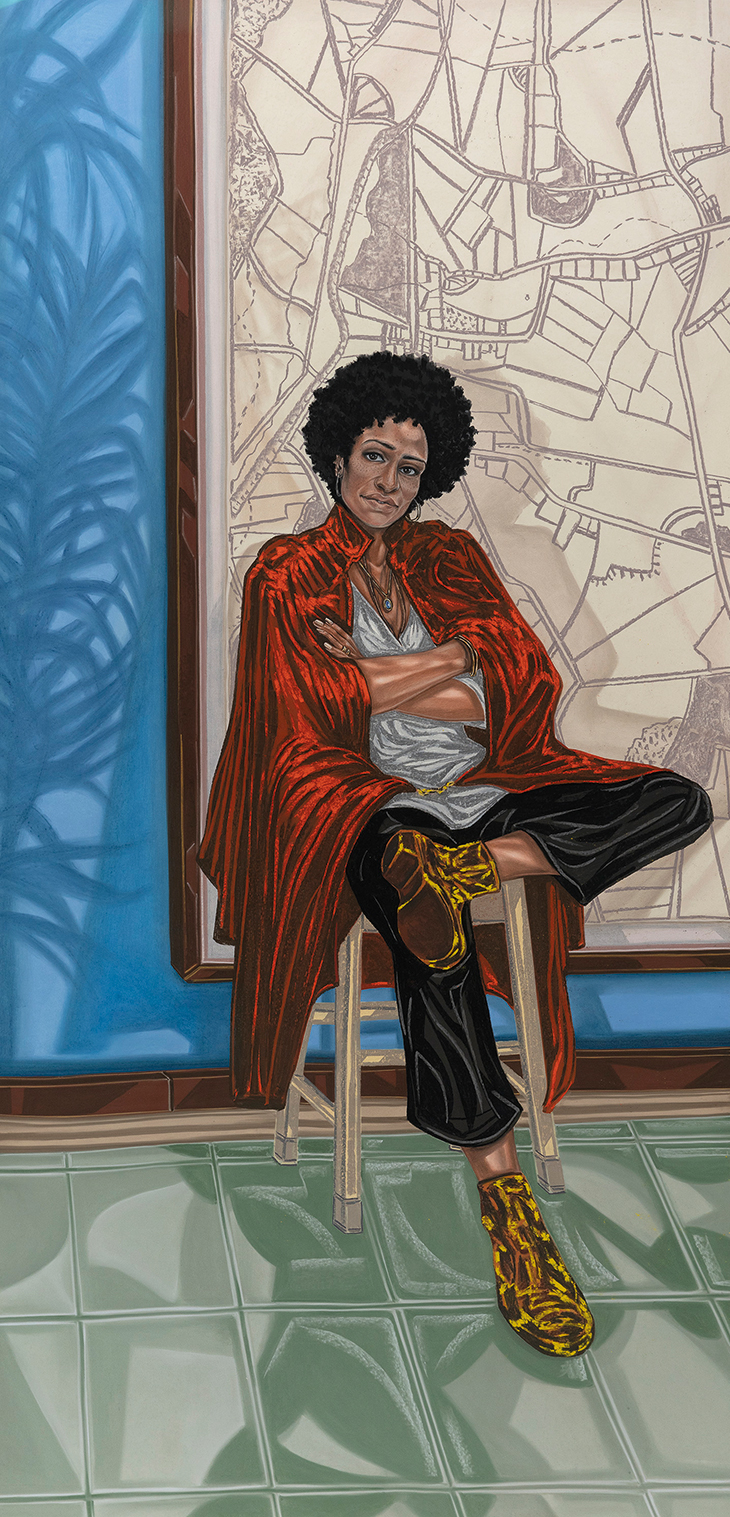Toyin Ojih Odutola
Toyin Ojih Odutola’s series A Countervailing Theory began, the artist has explained, with a single ‘wandering charcoal line’. It’s a phrase that calls to mind a number of similar expressions of spontaneity over the course of modern art history (think of Paul Klee ‘taking a line for a walk’), but in the case of Ojih Odutola, it still comes as something of a surprise. Visitors to the exhibition, also called ‘A Countervailing Theory’, at the Barbican in London (until 24 January 2021) could be forgiven for thinking the commission – a frieze-like cycle of 40 monochrome drawings, telling the foundation myth of an imaginary prehistoric civilisation – had its origins not in improvisation but in meticulously plotted storyboards. It is an absorbingly cinematic piece of storytelling; a tale of forbidden love between a woman of a warrior-like ruling class and her male subordinate, set in a surreal landscape reminiscent of the Jos Plateau in Nigeria and gorgeously rendered in layer upon layer of charcoal, chalk and pastel.
Ojih Odutola’s gift for world-building has set her apart as a graphic artist of extraordinary imaginative power in recent years. The writer Zadie Smith, a friend and supporter, has described the experience of entering an exhibition of work by the artist as that of ‘walking into a novel’. Yet Ojih Odutola has frequently pointed out that she does not think of herself as a writer. Her drawings never serve as mere illustrations to her stories; in fact, what is most compellingly original about the artist is the way that she harnesses mark-making as a driver of plot. The action of A Countervailing Theory takes place against a mutating backdrop of complex, changing patterns of lines – ‘striations’, as the artist has described them – that manifest the unspoken systems of oppression that govern the characters’ behaviour. The servile male underclass is distinguished throughout by curvilinear markings; in an early scene, we see these being carved into the skin by their female rulers, literally delineating their servitude until, in the final climactic moments, the lines become blurred. That ‘wandering charcoal line’ is, in a very real sense, the thread that holds together both the story and the world in which it takes place.

This is How You Were Made; Final Stages from A Countervailing Theory (2019), Toyin Ojih Odutola. Courtesy the artist and Jack Shainman Gallery, New York; © Toyin Ojih Odutola
Ojih Odutola was born in the city of Ile-Ife in south-western Nigeria, moving with her family to California in 1990 at the age of five. Faced with unfamiliar English idioms and local slang, she has explained that drawing quickly became a communicative tool – a way of making sense of a new world. While still a student at California College of the Arts in San Francisco, she presented her first solo show at Jack Shainman gallery in 2011 – a series of painstakingly detailed portraits in ballpoint pen, entitled ‘(MAPS)’, which sought to represent Black skin as a kind of geographical expanse (a ‘terrain of one’s being’, in her own words); the show sold out before its opening night.
Portraiture has remained an essential part of her practice; Jack Shainman recently held a display of portraits created during lockdown, while her depiction of Zadie Smith, commissioned by the National Portrait Gallery in London in 2019, epitomises both her exacting attention to formal texture and her intuitive empathy with her subjects. In 2015, her first museum show at Contemporary Art Museum St Louis marked a new direction by placing portraiture in the service of serial narratives. Before long she had begun work on an ambitious saga of two wealthy Nigerian families – one ancient nobility, the other nouveau riche – playing out in a contemporary world in which colonialism had never happened; it was presented in a trilogy of solo shows, at the Museum of the African Diaspora (2016), the Whitney in New York (2017), and Jack Shainman (2018).

Sadie (2018–19), Toyin Ojih Odutola. National Portrait Gallery, London. Courtesy the artist and Jack Shainman Gallery, New York; © Toyin Ojih Odutola
‘Flipping the script’, as the artist has described the kind of thought experiment that defines both A Countervailing Theory and the trilogy telling the story of the UmuEze Amara and the Obafemi clans, is on one level an attempt to cut through essentialist ways of thinking about oppression; as the narratives upend the power structures of the fictional worlds they conjure, which are themselves inversions of our own, they direct attention to the structures of oppression, rather than the actors. Yet this is only one side of the story; the worlds and the characters contained in her fictions are too lovingly and meticulously realised to be reduced to political fables. Lotte Johnson, curator of the Barbican commission, describes this as a kind of ‘generosity’. ‘She gives you a stake in the narratives that she’s presenting; allows gaps for you to make your own meaning,’ Johnson tells me – and perhaps this is the key to understanding how an artist who keeps her finger resolutely on the political pulse can produce works that are so wonderfully escapist. Just as the marks accrue in layers of charcoal, chalk and pastel, so do layers of meaning accumulate. By refusing to claim the final word, Ojih Odutola embraces a process by which her creations will continue to speak long after she has stopped working on them.
Samuel Reilly is editorial assistant at Apollo.
The Winners | Personality of the Year | Artist of the Year | Museum Opening of the Year | Exhibition of the Year | Book of the Year | Digital Innovation of the Year | Acquisition of the Year | View the shortlists


























